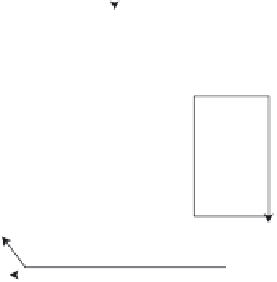Agriculture Reference
In-Depth Information
CO
2
Atmosphere
↑
Photosynthesis
↑
Respiration ?
Transpiration
↓
Plant
↑
↑
↓
WUE
Shoot C
Spec. LA
↑
↑
Yield
NPP
Above ground
↑
↑
LUE
Shoot C:N
Root : Shoot
ratio
↑
Total
system
C & N
Below ground
↑↑
↓
↑
Root C
substrate
N uptake
Root C
exudate
Root C : N
↑
↑
↓
↑
Soil
Gaseous N loss
N fixed
↑
(N immobilized)
SOM
Litter decomp.
↓
N Leached
↓
Mineral N
↓
Fig. 4.13.1.
Schematic representation of the impacts of raised atmospheric CO
2
on
agroecosystems. Arrows indicate the likely direction of the response. See text for further details.
Soils and the Kyoto Protocol
The Kyoto protocol (available at: http://www.cop3.de/) was formulated
in December 1997 by the 174 parties that ratified the United Nations
Framework Convention on Climate Change (UNFCCC). The Kyoto
protocol allows carbon emissions to be offset by demonstrable removal of
carbon from the atmosphere. Thus, land use/land management change and
forestry activities that are shown to reduce atmospheric CO
2
levels can be
included in the Kyoto emission reduction targets. These activities include
afforestation, reforestation and deforestation (article 3.3 of the Kyoto
protocol), and considered for future inclusion are additional activities such
as the improved management of agricultural soils (article 3.4).
There are three very important components of the Kyoto protocol.
First, it establishes an arbitrary baseline (1990) against which all carbon
emissions and carbon mitigation options are compared. Secondly, for
the 39 parties listed in Annex B of the Kyoto protocol, it sets quantified
emission limitation or reduction commitments for the first time. Thirdly, it
establishes a target period for emission reduction or mitigation (the first
commitment period; 2008-2012). For the European Union, this means a
reduction in CO
2
emissions to 92% of baseline (1990) levels during the first
commitment period (2008-2012).
Soils are likely to be most important in the 'additional measures' of
Kyoto Article 3.4 where the improved management of agricultural soils is
mentioned explicitly as a future possibility for carbon mitigation. It is the
opportunities and limitations of the methods to estimate carbon mitigation






































Search WWH ::

Custom Search